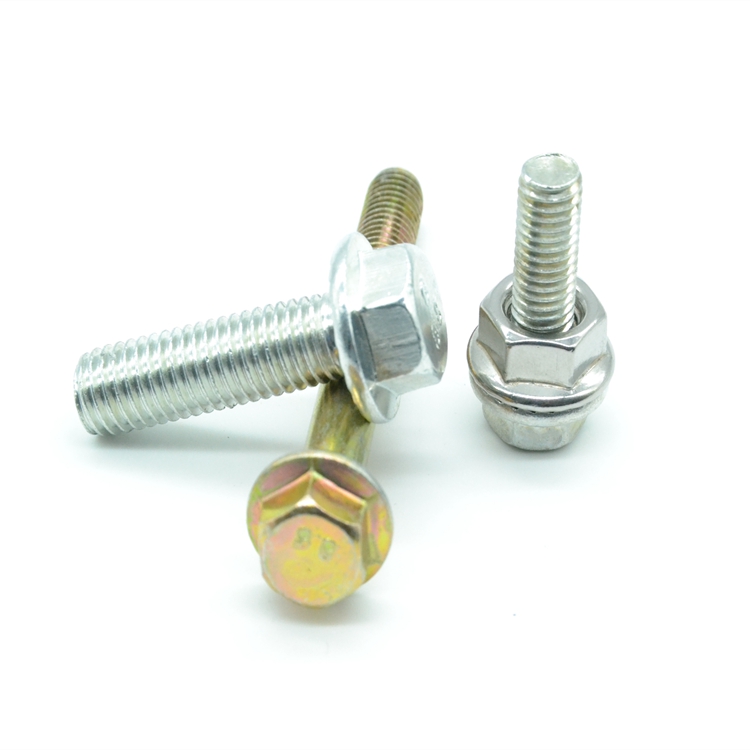Manufacturers of Black Oxidation Flange Head Bolts for Industrial Applications and Custom Solutions
Jul . 23, 2024 14:33 Back to list
Manufacturers of Black Oxidation Flange Head Bolts for Industrial Applications and Custom Solutions
The Importance of Black Oxidation for Flange Head Bolts in Manufacturing
Flange head bolts are crucial components in various industries, especially in mechanical and structural applications. These bolts provide robust fastening solutions that ensure the safety and integrity of assemblies in everything from automotive to aerospace engineering. One of the processes that significantly enhance the performance and longevity of flange head bolts is black oxidation. This article delves into the significance of black oxidation in the manufacturing of flange head bolts and its benefits.
What is Black Oxidation?
Black oxidation, also known as black oxide coating, is a conversion process that enhances the surface of steel parts without adding much thickness. This method involves chemical reactions that convert the surface of the metal into a magnetite (Fe3O4) layer, giving it a distinctive black finish. Many manufacturers, including those specializing in flange head bolts, opt for this treatment due to its numerous advantages.
Benefits of Black Oxidation
1. Corrosion Resistance One of the most significant advantages of the black oxidation process is its ability to improve corrosion resistance. The coating provides a barrier that protects the underlying steel from moisture and environmental factors that can lead to rust and degradation. This is especially important for flange head bolts used in outdoor or harsh environments.
2. Aesthetic Appeal The black finish achieved through oxidation provides a uniform and attractive appearance. This aesthetic quality is often sought after in applications where the visual presentation of fasteners is essential.
3. Reduced Friction Black oxide coatings help to reduce friction between the bolt and the materials being fastened, which can enhance assembly efficiency. This property is particularly beneficial in high-speed applications where reduced friction can lead to smoother operation and minimized wear and tear.
black oxidation flange head bolts factories

4. Dimensional Stability The black oxidation process does not add significant thickness to the part, preserving the dimensional tolerances of flange head bolts. This is critical in applications where precise fit and performance are required.
5. Improved Lubricity The black oxide layer can be treated with oil or other lubricants after the process, further enhancing the fasteners' lubricity. This allows for easier installation and removal of bolts, making maintenance and repairs more efficient.
Manufacturing Considerations
When selecting a factory to produce black oxidized flange head bolts, several factors must be considered. Quality control is paramount; manufacturers should adhere to strict quality standards to ensure the effectiveness of the black oxidation process. Additionally, the facility’s capability to handle large volumes while maintaining consistency is crucial. Modern factories often utilize automated systems to enhance efficiency and reduce human error in the manufacturing process.
Many manufacturers are also aware of environmental considerations and seek to employ eco-friendly practices in their processes. It’s beneficial to partner with factories committed to sustainable manufacturing, as this not only aligns with corporate social responsibility goals but can also enhance a company's market reputation.
Conclusion
In conclusion, the application of black oxidation in the manufacturing of flange head bolts is a vital process that offers multiple benefits. Companies looking to enhance the performance, durability, and aesthetic appeal of their fasteners should consider investing in this treatment. By working with specialized factories, manufacturers can ensure the production of high-quality black oxidized flange head bolts that meet industry standards and customer expectations. As industries continue to demand more robust and reliable components, black oxidation will remain an essential technique in the fastener manufacturing landscape.
Latest news
-
Reliable Axle Nuts Supplier | High-Quality Automotive Parts
NewsAug.19,2025
-
Premium Wire Bolts Suppliers | Durable & Reliable Fasteners
NewsAug.18,2025
-
Leading Metric Wood Screw Companies & Manufacturers
NewsAug.17,2025
-
Top Wire Bolts Suppliers - Quality & Durable Fasteners
NewsAug.15,2025
-
Trusted Wire Bolts Company | Quality Fasteners Supplier
NewsAug.14,2025
-
Reliable Wire Bolts Suppliers & Manufacturers for Global Needs
NewsAug.13,2025
